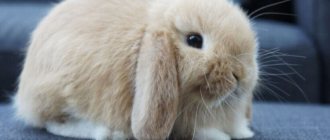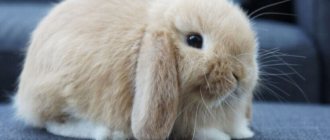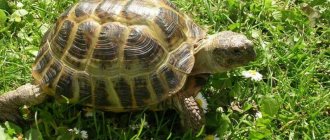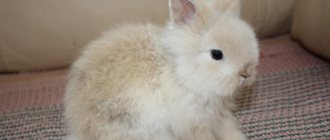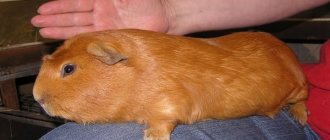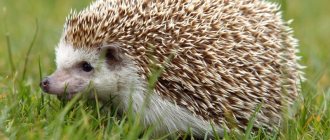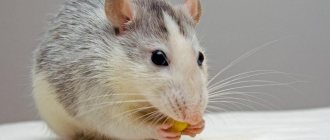Review author: “ZooVita”
The dwarf fold ram is the most popular breed of decorative rabbits. A cute animal with a charming face, cute floppy ears and a calm character, it is most suitable for children and beginners.
From the outside, a rabbit may seem like a toy, but it is a living creature that requires attention, care, and responsibility from its owner. In return, the handsome furry man is able to give love, devoted friendship, and a lot of pleasant emotions.
Before purchasing an animal, you need to study its habits, behavior, know what to feed a dwarf rabbit, and how to care for it.
History of the breed
Unusual lop-eared rabbits look very similar to small lambs. For the first time, C. Darwin spoke about them, who noticed in the litter of ordinary animals with erect ears, fold-eared babies. This phenomenon has interested breeders.
Already by the middle of the 20th century, breeders from Holland developed a new breed by crossing small decorative rabbits with French Folds.
Since 1964, the breed has been officially recognized. Dwarf rams appeared in Russia in the late 90s and immediately won the hearts of pet lovers.
Lion head
Little rabbits. Dwarf domestic rabbit breeds. Lion head
Judging by the name, rabbits of this breed are the smallest rabbits of all the above. The weight of an adult individual barely reaches 1.6 kilograms.
The weight of an adult individual barely reaches 1.6 kilograms.
The unique structure of the ears and the fur framing the muzzle and ears give this animal the appearance of a lion. Thanks to the short hair on the body, the head looks even larger than it actually is. Sometimes, but really very rarely, it becomes possible to find a species of dwarf lion's head, which, along with long hair on the face, is also decorated with long hair on the sides. Compared to their counterparts, the care and maintenance of these small rabbits is quite simple. Short hair does not require constant brushing, as it does not tangle or mat. Another, no less interesting feature of lion head rabbits is the beautiful edging around the eyes.
Rabbits of this breed are distinguished by their miniature but strong bodies. Their eyes always match the color of their fur coat, which can be completely different. The appearance of rabbits of this breed is quite charming; erect ears, a large head, strong and small paws will not leave anyone indifferent. It is impossible not to note the pliable and soft nature of pets, which can easily replace a real friend for a child. My only recommendation is that these rabbits simply hate being picked up by their ears.
Peculiarities
A distinctive feature of the dwarf ram is its thick, drooping ears. Their size varies from 25-30 to 65-70 cm. They are rounded at the ends and resemble a horseshoe.
A baby rabbit 45 days old weighs 0.45-0.5 kg, an adult dwarf lop-eared rabbit - 30-35 cm weighs 1.6-2.2 kg.
The animals have a large head, a powerful back of the head, a large forehead, and eyes like almonds.
The cylinder-shaped body is covered with soft, shiny fur, similar to silk. The villi are short, medium and long. Color, pattern, markings, and undercoat indicate a representative of a certain breed.
The character is calm, balanced, the animals are patient and easy to make contact with.
Hermelin
Little rabbits. Dwarf domestic rabbit breeds. Hermelin.
This small white rabbit is also called the Polish rabbit or stoat. This breed has a very interesting history; previously it was bred specifically to produce skins reminiscent of ermine. The main feature of the Hermelin breed is the exclusively white color of not only the coat, but also the claws and skin. The eye colors of rabbits of this breed are blue and red. Small rabbit ears flaunt on a relatively large head. In general, the rabbit resembles a small toy, but it looks very impressive.
Due to their rather thick fur, they practically cannot tolerate heat. The character traits of both females and males are quite unique. Males are very lazy, they do not like being disturbed unnecessarily. Females, on the contrary, are active, but a little aggressive. But, all these features are quite individual. In general, breeding or keeping rabbits of this breed is recommended only to experienced rabbit breeders.
Varieties
Breeders all over the world tried to create their own animal with floppy ears, which is why there were so many breeds. Among them there are both dwarf and rather large specimens.
Please note ⭐⭐⭐
Degu (Chilean squirrel): photo and description, keeping at home, how long they live
Marmots (Marmota): interesting facts, habitat, what it looks like, color, size, photos, types
Domestic chinchilla: recommendations for keeping it at home, types, color, character, how to feed and care (150 photos)
Pros and cons of content
Dwarf rabbits are affectionate and clean, but very susceptible to disease
There are advantages and disadvantages to owning these small, cute animals. Let's start with the pros:
- Cleanliness. Dwarf long-eared cats quickly become accustomed to the litter box, and there is very little litter from them in the apartment.
- These are affectionate, kind pets that immediately become attached to their owners. When they are happy, they click their teeth funny and make pleasant sounds.
- Rabbits are unpretentious in care and nutrition, and their maintenance is quite inexpensive.
The main disadvantage of animals is their pain. They can fall ill not only from infection, but also from sadness. Frequent visits to the veterinarian can take a lot of effort and time. Another disadvantage is the problem of constantly gnawing on something. Buying toys will help solve the problem: the rest of the things in the house will remain intact.
It is also worth considering that each rabbit, despite its small stature, is a personality. They are very touchy and remember bad treatment for a long time.
Care
Keeping a dwarf rabbit at home requires a caring and responsible attitude.
The optimal room temperature is from 16°C to 23°C. The sun's rays falling on the animal can lead to heat stroke.
The cages must be clean and spacious. The tray, drinking bowl and feeder are washed every day, the bedding is changed 4 times a month. It is highly undesirable to use plastic cages as they emit harmful substances. It is better to treat wooden specimens so that the pet does not get hurt.
Problem areas and dirty fur are wiped with a damp cloth, then wiped dry, long nails are trimmed.
Colored dwarf
Little rabbits. Dwarf domestic rabbit breeds. Colored dwarf
This breed is also known to many as the short-haired dwarf rabbit. Typically, the body weight of an adult colored dwarf can range from 800 grams and barely reach one and a half kilograms . The animal's ears are always positioned upright, their length can vary from 5 to 5.5 cm. Despite their miniature size, practically absent neck and small body, the paws of rabbits of this breed are very strong. At the moment, more than 60 colors of the colored dwarf have been recorded. The fur coat of these pets has a very neat appearance and does not require special care.
It should be noted that during puberty, rabbits of these breeds can show aggression towards the owner, even sometimes biting or hitting with their paws. Typically, maturation occurs at one and a half years. Many sellers recommend spaying or neutering these animals to reduce aggression.
To summarize, we can conclude that the colored dwarf is quite funny and perfectly plays the role of a charming, active and funny pet.
Reproduction
The pregnancy of a female dwarf breed lasts from 29 to 32 days. In one litter she brings from 3 to 7 rabbits. When the babies are 2 weeks old, they begin to climb out of the nest on their own. The young are separated from their mother at the age of two months.
Newborns require special care. They must be protected from direct sunlight, wind, dust, and high humidity.
Why are decorative individuals needed?
For games
Their purpose is quite clear from the name. Decorative breeds are not intended for breeding for meat or skins. These babies are bred as pets. The variety of species allows each person to choose his favorite. Outwardly, these are cute and cute animals that have not only an attractive appearance, but also a special character.
Yes Yes. Decoratives have their own habits, their own fears or pleasures. These are calm but cheerful animals. They do not conflict and respond adequately to external stimuli. But there are also capricious species that require a special approach.
Lifespan
Representatives of dwarf breeds live mainly 5-7 years. If you take good care of them, this period can reach 10-12 years. Important:
- do not create stressful situations;
- you cannot shout or make sudden movements that may scare the rabbit;
- when traveling, use a special bag;
- carry out vaccinations;
- high-quality nutritious food.
When purchasing, you should pay attention to affectionate breeds so that the animal quickly gets used to humans. The child must understand that one should not hurt living beings, that one must treat them with care.
Rex
These representatives of decorative rodents are also known as royal rabbits. The short fur of the animals has a shiny color that looks like velvet, which makes it seem like they are wearing a kind of palace cape. Today, Rex rabbits have the most numerous choice of colors.
Miniature animals are representatives of not the smallest breed of rabbits. The weight of a healthy individual typically reaches a mass of 1500 grams. The pointed shape of the head, exquisite antennae and ears directed upward at an angle of 45 degrees are the distinctive features of this decorative animal.
Rex rabbits of any age have an affectionate and kind character. But a cute rodent is not able to respond to a nickname and cannot have much affection for its owner.
Photos of dwarf rabbits
How to toilet train an animal
Accustoming a baby rabbit to a litter tray requires a lot of patience from the owner.
The little rabbit is gradually getting used to the toilet, but you will have to be a little patient. It is advisable to remember in which corner the breeder had the tray and place it there at home. It is worth asking the breeder for some used litter and mixing it with the old one. The pet will quickly find its native smell.
If the baby doesn't get into the tray, there's no need to swear. As soon as it becomes noticeable that your pet wants to go to the toilet, you must immediately put him in the litter tray. After a job done successfully, the animal should be praised. If you patiently train your pet to use the toilet day after day, the result will be achieved.
Mini lop cashmere (long-haired)
The first long-haired rabbits were obtained by chance in a litter of standard dwarf rams. This happened in 1980 in England. It was these animals that became the founders of the Cashmere Mini Lop breed.
Characteristic:
- Weight: 1300-1600 g.
- Ear length: 20-24 cm, drooping.
- Coat: long (from 3.8 to 5-6 cm), shorter on the head.
- Color: any.
- Price: 7.5-13 t.r.
Cashmere mini lop has a dense, strong, but small body. The croup is rounded. The neck is very short, almost invisible. Both the forelimbs and hind limbs are thick and short. The peculiarity of the breed is its long, soft, but not plump, hair that is always straight.
Nutrition
So, you brought a new pet home and the question arises: what to feed your dwarf rabbit?
Make sure your rabbit always has access to a drinking bowl with water. The diet must include succulent foods: cucumber, carrots, beets.
King of the Giants Ralph
There are also real eared giants. Their weight exceeds 10 kg, and their body length is more than 1 m.
The largest rabbit in the world now is a pet named Ralph. He is a Guinness Book of Records champion. Its weight reaches 23 kg. Ralph's parents were also record holders.
Before Ralph, this honorary title belonged to a giant rabbit named Darius, whose weight was 19 kg with a body length of 120 cm. He eats a couple of heads of cabbage a day, carrots and apples, and also loves bread and corn.
This rabbit is comparable in weight to a 3-4 year old child.
Possible problems
In addition to the impressive list of advantages of keeping decorative rabbits, you need to familiarize yourself with the disadvantages, which, unfortunately, are many.
You need to take care of the cute little ears every day - trim their claws if necessary, comb their fur, and monitor their health.
If care is poor, an unpleasant odor begins to emanate from the cage or enclosure where rabbits live. And if you leave an animal alone for several days, even its fur will begin to smell stench.
The living area of decorative rabbits must be cleaned every day. But it is not always possible to devote enough time to this procedure.
Despite the fact that rabbits are loyal to furniture and corners, when free to roam in an apartment or house, they are capable of chewing through wires, easily accessible things, and also scratching wallpaper.
The molting period of decorative rabbits is considered one of the most difficult
The owner of the animals has to pay extra attention to the pet’s fur and comb it thoroughly. And then clean his territory and the area close to the enclosure from small hairs.
The dimensions of the cage for keeping decorative rabbits are of decent size; accordingly, the room for its placement should be spacious.
Despite the usual cute image, the character and behavior of many breeds of decorative rabbits is not soft.
They will not ask to be held; on the contrary, once in the owner’s arms, they may begin to kick, kick with their hind legs, and some even bite.
Mature decorative rabbits begin to mark their territory. They scatter waste from their own body throughout the enclosure, and after indoor walks the owner will have to clean the floors of feces. The smell from the rabbit will be appropriate, but only sterilization will help get rid of it. Another disadvantage is mandatory vaccination.
In general, keeping decorative fluffies with long ears is not difficult if a whole family lives in the house. It will not be easy to maintain them alone; a sufficient amount of time and effort is spent on them.
